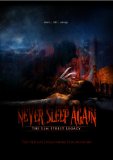| Reviews & Columns |
|
Reviews DVD TV on DVD Blu-ray 4K UHD International DVDs In Theaters Reviews by Studio Video Games Features Collector Series DVDs Easter Egg Database Interviews DVD Talk Radio Feature Articles Columns Anime Talk DVD Savant Horror DVDs The M.O.D. Squad Art House HD Talk Silent DVD
|
DVD Talk Forum |
|
|
| Resources |
|
DVD Price Search Customer Service #'s RCE Info Links |
|
Columns
|
|
|
Never Sleep Again: The Elm Street Legacy
- Wes Craven
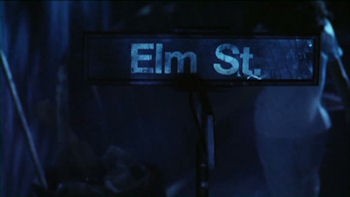
The Movie
I feel compelled to tell you something, but I'm afraid you'll turn on me. I think I can win you back, so just stay with me. Okay (deep breath!), here goes: My heart belongs to Jason. Partially because Friday the 13th was the first modern horror film I saw when I was a kid--and partially because I find a slasher chasing me through the woods more realistic and scary than a wisecracking comedian getting silly in my dreams, where there don't seem to be any rules--I've always had more of an allegiance to and affinity for the Friday films. So when Freddy vs. Jason rolled into theaters in 2003, I was solidly in the corner of the hockey-masked icon. To make you hate me even more, here's another confession: Freddy ain't even my No. 2 man (that goes to Michael Myers). What can I say? I like my murderers slow and silent.
Don't get me wrong: I've enjoyed plenty of the Nightmare on Elm Street films, and love the original--a classic that put a refreshing spin and energetic jolt into a genre in desperate need of originality. But the majority of the sequels are a little too hammy for my tastes: They're more fantasy-driven stories with eye-rolling catchphrases where anything goes, not anything that comes close to actually spooking me. But when it comes to the documentaries chronicling the three longest-running and most-popular horror franchises, the Nightmare entry Never Sleep Again: The Elm Street Legacy is king. It puts His Name was Jason to shame, and is also more impressive than the solid Halloween: 25 Years of Terror (producer/director Daniel Farrands had a hand in all three efforts).
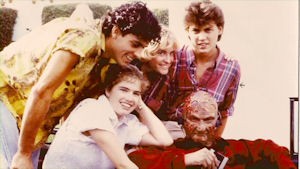
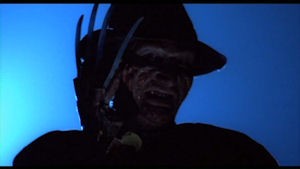
Running a gloriously exhaustive four hours (and that doesn't even include the extensive bonus features on the second disc!), Never Sleep Again is a valentine to the series. Broken into 10 main sections that cover every film in the series (excluding the recent remake) and the short-lived TV series, it's a treasure trove that strikes the perfect balance of being informative, funny and unafraid to explore controversy. While there aren't any magical revelations or groundbreaking documentary techniques employed, the sheer scope and love put into the project makes it an indispensible disc for horror fans (even moderate franchise fans like me will gain a new excitement and appreciation for the films). It also stands as a great testament to the filmmaking process, the power of horror movies and the perfect examination of the American Dream as it chronicles the rise of a little distribution company that put itself on the map.
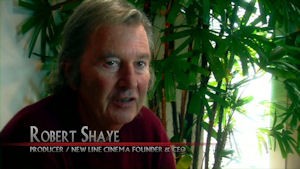
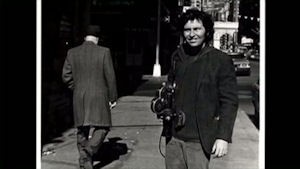
By my amateurish and possibly inaccurate count, there are 99 contributors in the main feature alone (I counted Dokken as three), with even more in the bonus features. They range from New Line executives, directors, producers, writers and special effects gurus to crew members and a whole lot of actors (most introduce themselves with a really cool reading of their character description from the screenplay; equally awesome are the stop-motion animation sequences that bridge the segments). Not only do you get obvious contributors like Wes Craven, Robert Englund and Heather Langenkamp (who also provides minimal narration), you also get memorable bit players like "Surfer #2" (Daryl Hannah's brother, Don!), "Hall Guard" (Leslie Hoffman) and "Girl on Bus #2" (Jo Ann Willette)...how sweet is that?! The four hours fly by, and you'll become engrossed in the addicting stories and anecdotes. With all of the key players providing their input throughout, the segments are connected beautifully and give the film great cohesion. And unlike the disappointing His Name Was Jason, everyone here takes this documentary and the films seriously.
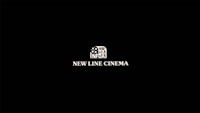
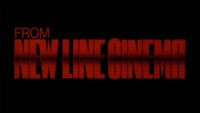
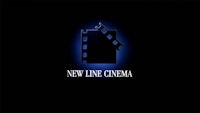
Diehard fans have probably already seen the behind-the-scenes efforts included on previous releases: The 1999 series box set included a bonus disc bolstered by the 46-minute "Ready for Primetime" feature (additional clips on the sequels were also found in the "Labyrinth"), while the 2006 Infinifilm Special Edition of the original included the 49-minute "Never Sleep Again: The Making Of A Nightmare On Elm Street" (while it has the same title, this was a different work) along with a 22-minute feature on New Line Cinema. The majority of those pieces focused entirely on the original, so a lot of the Part 1 stories shared in this new documentary--from Craven's inspiration for the story, Freddy and his weapon to the special effects and the growth of New Line--will be familiar. But it still presents a horde of new contributors and all-new interviews that manage to uncover a wealth of new information (for more on the previous releases, see the note at the end).
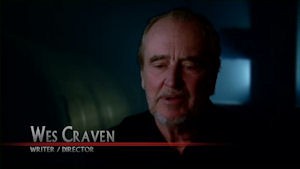

Present throughout the proceedings are Craven, Englund, Langenkamp and the New Line nucleus: founder Robert Shaye, producer Sara Risher and woman of all trades Rachel Talalay. After a brief introduction, Part 1 is examined in "Don't Fall Asleep" (40 minutes). "In my mind, the killer of children is about the most despicable thing you can think and the deepest and most profound betrayal of the innocence of a child," notes Craven. But with the infamous McMartin preschool trial heating up the headlines in 1983 and 1984, the production had to be careful. "We had to soft-pedal the sexuality a little bit, but that was probably even better because it becomes subtext," says Englund, who adds that he became very aware of his character's powerful silhouette and shadow--and made conscious choices to exploit them. "Freddy's in those teenage girls' bedrooms. He's in their bed with them. He's in their dreams with them. And that's about as much you could ever hope to violate anyone. That's more violation than rape, and so I think that in and of itself is one of the great hooks to A Nightmare on Elm Street."
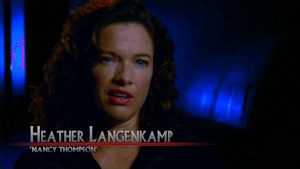
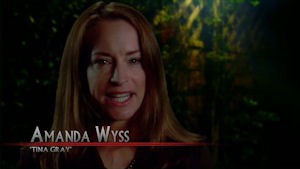
Hard to believe, then, that the design for the infamous killer's look was inspired by...food? Special makeup and effects designer David Miller explains: "The final design for Freddy was based on pepperoni pizza. I was at a restaurant one night and I was having pizza, and kind of deep in thought. I started playing around with the cheese, putting it around the pepperoni...and I actually made Freddy's face on the pizza." The legendary rotating room (which was re-used in Breakin' 2: Electric Boogaloo!) is once again explored (not quite as in-depth as it was in the 2006 feature), with frequently imperiled actress Amanda Wyss on hand to discuss the torment she endured on the shoot. "Your body does not want to be in a body bag when you're still alive," says the imperiled actress. "Your body and your brain says, 'Don't let them zip this up!'"
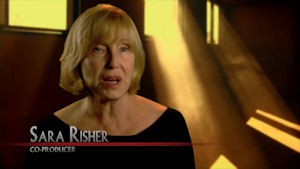
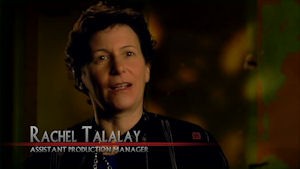
Cinematographer Jacques Haitkin hated the extending-arm marionette effect ("It looked ridiculous"), while tensions between Craven and Shaye surfaced. The director wasn't fond of the Bisquick stairs or the ending he had to tack on, thus compromising his vision ("I gave him his hook," says a complacent Craven). Says Shaye: "I've been accused of fighting for a movie that could have sequels, but that wasn't really the case. I just felt that the ending to the movie didn't send the audience out with any great excitement." As for Nancy's mom being sucked through the tiny door window? "The effect with Ronee [Blakley] works great on film," notes Englund, "but when we shot it, it was pretty silly shit."
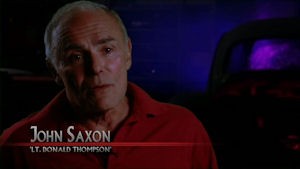
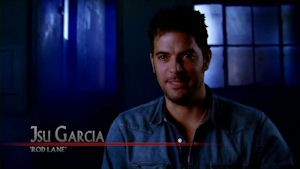
Blakely isn't here, but thankfully the legendary John Saxon--one of the baddest asses that ever graced the screen--is (listen for Craven's hair piece story). Also absent is (surprise!) Johnny Depp, although the cast and crew share their memories of him (a very brief clip from an Inside the Actors Studio interview will have to do) in a role that Charlie Sheen turned down (he wanted $3,000 a week). New to this edition--and surprisingly touching--is Jsu Garcia. He played Tina's boyfriend Rod--but did so under the name Nick Corri after his agent told him that Latino actors would never make it in Hollywood (he was told to "play Italian"). Of his memorable jail cell scene: "I really regret that I brought a substance and changed my acting," he says, noting that he wasn't crying because of the scene but because he had a shitty life. "But I've been clean after 25 years, sober."
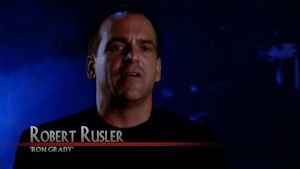
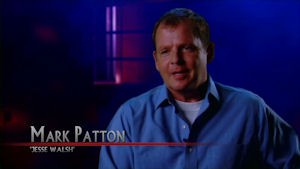
Who knew this doc could get so serious? It's time for a laugh. What better way than with "Kill for Me" (27 minutes), the most entertaining segment? This examination of Part 2 is reason enough to have this in your collection. Long loathed by many a franchise fan, the underappreciated Freddy's Revenge has gained cult status through the years for its so-obvious-it's-shocking homosexual themes. "When you suddenly cast your male lead in the victim role and then you have him scream like a girl for 90 minutes, uh...you're gonna have some people going, 'Well, you know, that's not the manliest performance I've ever seen," says line producer Joel Soisson, one the doc's secret weapons. "We made Nightmare 2 absolutely clueless that it had any gay undertones whatsoever. But looking back? It was so gay, it's amazing."
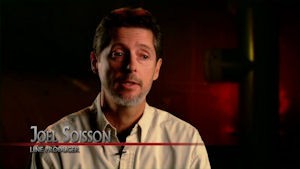
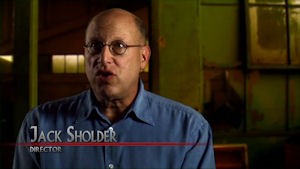
But director Jack Shoulder (who previously helmed the cool New Line slasher Alone in the Dark) insists he was clueless: "I simply did not have the self-awareness to realize that any of this might be interpreted as gay." Adds lead Mark Patton: "I actually don't think that originally Jesse was written as a gay character; I think that's something that happened along the line by serendipity." Not so insists screenwriter David Chaskin, who knew exactly what he was doing: "It was supposed to be subtext," he says with a smile. "I kind of think it was this subliminal thing that was going on in Jack's mind where he didn't really realize it, but everything he did amplified it."
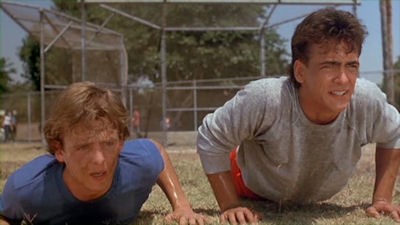
Jesse was placed in the traditional female role being "seduced" by Freddy (apparently Brad Pitt and Christian Slater also read for the role). Patton--gay in real life, too--admits he was revealing who he was through the character (although he did not want to film the festive dance scene: "If there was one thing that I could delete from my filmography in my entire life..."). Some of the production designer's intriguing choices also get a nod (the Probe game is pure perfection, the best prop in any film ever made), while some juicy bits of dialogue are also isolated.
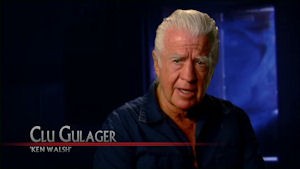
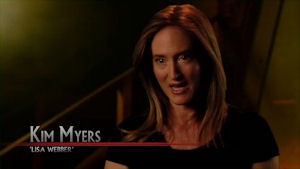
It's refreshing that everyone here is so candid and comfortable discussing the obvious themes; they all get a kick out of it--a nice sign on how far society has come in 25 years--and this segment is full of winks and laughs, I was smiling the entire time. "In terms of the kinky gimmick of Part 2, I think it's really interesting. Freddy could represent the self-hatred in the gay community; he could also represent just the taunt," says Englund. "Nightmare on Elm Street 2 rocked Europe, because they picked up on the whole psychosexual, homoerotic subtext. They love that in Europe."

Also on hand is Lisa Webber (how can someone be even more gorgeous 25 years later?!) and Weird Science vet Robert Rusler (who played Jesse's BF Ronny), who prompts a few chuckles of his own (another random fact: Rusler was driven to his audition by Robert Downey Jr.!). Marshall Bell (aka S&M loving Coach Schneider!) is here, while Shaye--who wanted a small role in the film--talks about buying his bartender wardrobe. Then there's good ol' Clu Gulager, who's as funny as you would expect: "When I was shooting, I had no notion that this was happening...although, I didn't get a blowjob on the set, if that's what you mean."
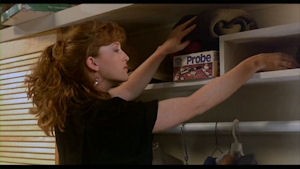
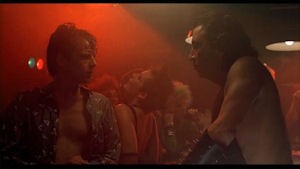
The segment also covers the effects, from the cool (Jesse's transformation) to the not (killer parakeet); the film's decision to take Freddy out of the dream world ("I was never a huge fan of the original," says the director. "I understood why it was good and I understood why it was successful, but I felt no compunction to follow the template of the first film"); and the shots filmed with an extra playing Freddy ("He was just atrocious," says Shoulder. "He would walk like a dime store monster; he would sort of hunker around...he was just terrible"), a decision necessitated when the studio initially didn't want to pay more for Englund. The only thing missing to make this retrospective perfect? Hope Lange, who sadly passed away in 2003 (Patton pays nice tribute to her in the extras).
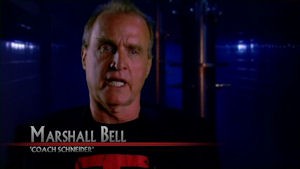
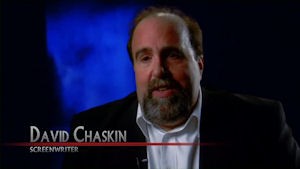
Also not here is Patricia Arquette, who made her feature film debut in Part 3. But by the time "We're the Dream Warriors" (33 minutes) nears its end, I'm guessing she had no interest in revisiting her experience. Apparently, working for director Chuck Russell wasn't the best experience for many people. Talalay explains how Arquette's first day on set didn't start until 4:30 in the morning--where she needed cue cards to get through her lines. "Chuck never got over that original discomfort...and never really gave her the support that I thought she deserved," Talalay says. Adds Ken "Kincaid" Sagoes: "There was a couple of times that...I think Chuck did not know how to speak to some of us actors."
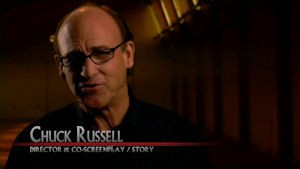
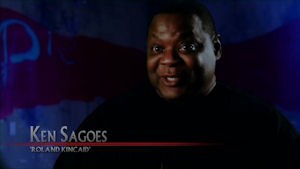
Russell smiles through all of his segments, and while he doesn't directly address those statements, he says he wanted to instill a sense of fear and tension and take the actors "to the edge." The director was having his own battles with executives, who weren't sure his more fantasy-driven work was the right path for Freddy or the franchise."It couldn't be more frightening than what Wes did in the original. But I thought adding an element of wit and black humor would balance out some of the really dark imagery in the piece," says Russell, who says the huge success of Dream Warriors set the tone for the films that followed and paved the way for their success. Counters Craven: "The fact that they made Freddy more and more jokey, took him farther and farther away from that child molester thing, that just kind of sticks to you in maybe a way that you don't like."
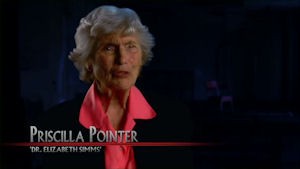
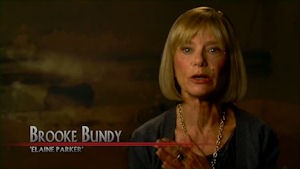
Save for Bradley Gregg (Phillip of the fantastic tendon puppet scene), all of the Elm Street kids return here--including Langenkamp, whose presence was vital to the film (unfortunately, leading man Craig Wasson isn't here nor even mentioned; perhaps another story waiting to be told?). You also get the awesome Priscilla Pointer ("I thought I was a good guy!") and Brooke Bundy, who explains that she drew on her difficult relationship with her real-life daughter to play the mom of Arquette's Kristin (I squealed like a little girl when I discovered that Bundy's daughter is Tiffany Helm, a.k.a. Violet from Friday the 13th: A New Beginning!).
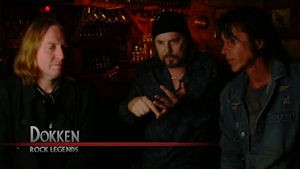
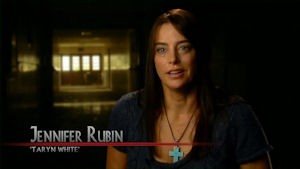
Saxon returns and disses his stop-animation battle with Freddy's bones: "I didn't like the scene." (You and me both, John!) We also learn why Zsa Zsa Gabor was selected as the talk show celebrity, and the kill scenes are explored--including the giant snake that almost devours Kristin. "He just said, 'This looks like a penis,'" says special effects man Kevin Yagher of Russell's reaction. "And I said, 'Yeah...remember? We had meetings about this...'" (Let's just be thankful that the team ditched the original idea behind mute Joey's seduction, where the nurse's head morphed into the killer: "Freddy with breasts?" says cinematographer Roy Wagner. "It was too off-kilter.") Capping off this segment is a quick visit with Dokken, where lead singer Don marvels at the success of the song he can't sing anymore: "It's so high. Even when I did it...probably [in my] early 30s...it was just too frickin' high."
As we move to Part 4 in "How Sweet, Fresh Meat" (29 minutes), the contentious but amicable relationship between the New Line founder and a young new director takes center stage. "Bob Shaye was sure that he had made the wrong choice all through the production. So he would come to the set, look around and have this really grumpy expression on his face, and this really sort of suspicious look--like, 'This Finnish guy has no idea what he's doing!'" says Renny Harlin, noting he was very scared stepping into the film and its $5 million budget (for him, a huge sum). "I would try to work hard and come up with great ideas and win him over, but I couldn't. He pretty much never spoke to me during the whole production."
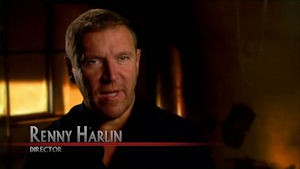
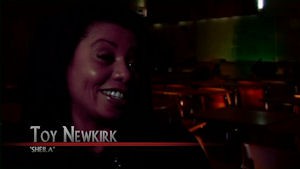
Harlin also didn't make the best impression on Toy Newkirk, who says the director asked her to dub her lines in post because she "didn't sound black enough." She refused, but as with Shaye, she has a good sense of humor about the experience and has clearly patched up any hard feelings with the good-natured, lovable director ("I don't remember this," he says of the request. "I'm from Finland...what do I know?"). This segment gives us our first look at attractive (on-screen) couple Lisa Wilcox and Danny Hassel, who give us some great moments throughout the two discs--they're both informative and funny.
A writer's strike spelled doom for the script, which was made up along the way. "What I felt was very important was to sort of re-invent the series. From the very get-go I said, 'I feel that Freddy has sort of become like [the] James Bond of horror films, and we should make him--in a way--the hero of the movie," recalls the director, who opted for a more colorful, action-like style to the film, something that invigorated a tired Englund--who wasn't completely into it when it started. "I went, 'Ahhh...this is the MTV Nightmare! It's energetic, it's kinetic. They were using tricks and techniques both in camera and for post that I couldn't imagine. I was so excited seeing that, and I literally got my second wind that night and for the rest of the shoot."
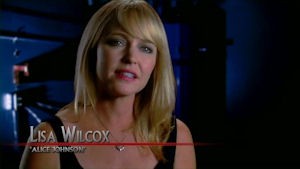
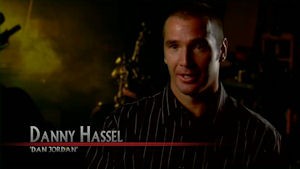
The film was also silly, and Harlin is the first to admit it: "I thought that was kind of goofy and stupid," he says of the robot arm. "It was like from another movie. I don't know what I was thinking." Color him surprised, then, when the film was a huge financial success and actually got some good reviews from respected critics (Kevin Thomas of the Los Angeles Times called it "by far the best of the series"). "They found all kinds of hidden meanings in the movie that I didn't even know the movie had, and I was completely blown away," says Harlin, adding that his life instantly changed after the opening weekend. So did Nightmare merchandising, which got a little ridiculous: "Some company even made Freddy pajamas for little kids," recalls writer David J. Schow, who pitched a Part 5 script. "Considering Freddy started out as a child molester..."
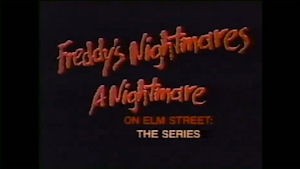
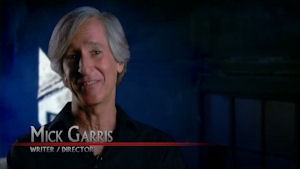
A TV interlude awaits us next, as "Welcome to Primetime" (15 minutes) explores the short-lived syndicated series that angered moms across the Bible Belt. "They really didn't care about the show," says writer/director William Malone of the executives. "It was just a cash cow. So we ran amuck." The project attracted actors like Brad Pitt and Mariska Hargitay along with genre directors like Tom McLoughlin and Mick Garris. "We really crossed the boundaries quite often in terms of what was acceptable on commercial television," says the latter. And with a clip of Freddy mounting a bare-chested teenage boy in bed ("Ride 'em cowboy!"), I believe it (who knew Freddy was a bottom?!).
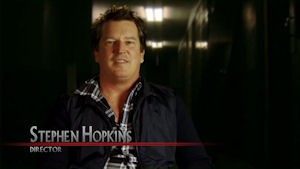
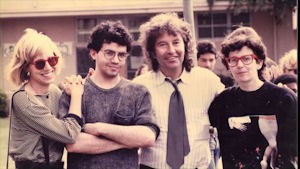
Up next is "It's a Boy!" (23 minutes), where we look at The Dream Child. Once again, the script was a work in progress: "Visually very interesting," says rejected screenwriter John Skipp (whose treatment was "too Kubrick"). "But I think that a lot of those things were attempts to cover the fact that they had liposuctioned all of the soul and intelligence out of the story." Director Stephen Hopkins opted for a darker tone and more of the visual style employed in Part 4, and even he admits to some mistakes: "Obviously, the comic book scene is preposterous." Freddy's makeover is also addressed ("No where as refined," says makeup man Howard Berger), while New Line's Sara Risher says she came up with the idea for the film--which skewed slightly more adult and (sort of) throws a controversial topic into the mix. "Maybe it shows abortion's a good thing," says a joking Hopkins (don't send the letters to me, folks!), while Englund is probably more on the mark: "I think it was like controversy for controversy's sake." But it's Whitby Hertford--now a little older than young Jacob--who wins the prize for best story, recalling the first day on the set when he met Englund: "I almost took a dump."
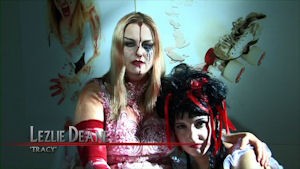
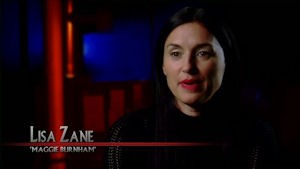
While Rachel Talalay had no involvement in Part 5 (her first absence from the series), she took on the directing and writing chores for Freddy's Dead--explored in "Every Town has an Elm Street" (17 minutes). Perhaps her experience working with John Waters colored her vision (she even cast Divine in a role, but the actor passed away), a choice that she admits may have been a mistake. "We intentionally made a decision to kind of do a Warner Brothers' cartoon," says Englund. "We jumped the shark a little; I'm not gonna deny that...but we wanted to do it that way."
We hear about defying Nintendo, the 3D gimmick and some dry humping between Roseanne and Tom Arnold, while Alice Cooper talks about cleaning up his act for his role. (Actress Lezlie Deane has clearly followed the opposite trajectory with her makeup--and don't ask me about her silent friend) Breckin Meyer and Yaphet Kotto are no-shows here, but at least we get another clip of Johnny Depp in his "Guy on TV" role.
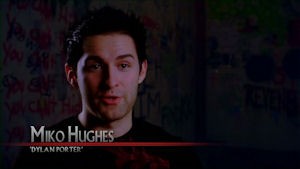
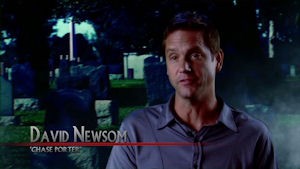
The series was saved by the return of Craven and Langenkamp in New Nightmare, and the documentary takes a fittingly less-funny and more serious tone during "Meet Your Maker" (24 minutes). Similar to the eerie real-life drama that haunted Adrienne King after her work in Friday the 13th (material she helped use for her brief scene in Part 2), Langenkamp shares her own stalker story--brought about by the cancellation of the Emmy-winning series Just the Ten of Us (which, ironically, featured two other Nightmare women). The incident helped shape the film's "fact blending with fiction" story (as did a real-life earthquake in Northridge), although David Newsom isn't sure he was enough like the star's real-life husband ("I'm the dorkiest special effects guy") and is definitely sure he didn't scratch his balls on camera (yes, you read that right).
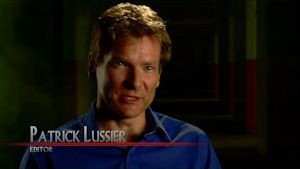
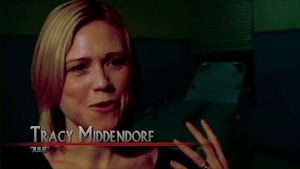
Craven still wonders whether his story choice was a mistake, the doubt perhaps brought on by the dismal box office (opening the same night as Pulp Fiction probably didn't help). But he stands behind his vision and its themes: "This is something that's ageless--that's kind of what I wanted to say. This kind of movie, this kind of story could be found in The Odyssey, could be found in Greek tragedies...it's the type of story that's been part of humanity for millennia." Adds Shaye: "It was almost a little too unique and cerebral, so it wasn't so much scary. It was just clever." Nonetheless, the work gained respect and a new following on home video--and also helped influence Craven's soon-to-debut Scream series (also edited by Patrick Lussier, who appears here; now a director, he helmed the My Bloody Valentine remake and is currently working on the new Halloween III).
Wait...time out. Just the Ten of Us won an Emmy?! Oh, it was for lighting? Okay, carry on...
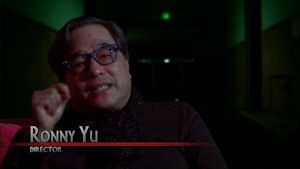
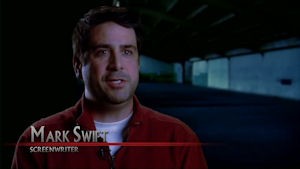
Our final stop brings us to the match of the century, as Freddy vs. Jason is examined in "Place Your Bets" (22 minutes). If you thought Part 5 had too many writers, wait until you hear about the development of this project. Director Ronny Yu admits he wasn't a fan of either series, but that turned out to be the fresh perspective that New Line wanted: "When I was making Bride of Chucky, I learned, 'Don't take this too seriously. Have fun with the monster.' So I used that sort of principle." Co-writer Mark Swift notes it was vital to keep both mythologies intact, and takes issue with some dialogue changes he wasn't aware of until he saw the film (he hates Kelly Rowland's final speech to Jason before she gets killed, especially taking issue with the use of the word "faggot").
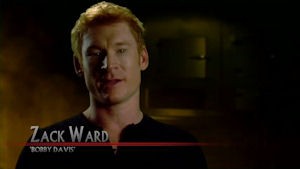
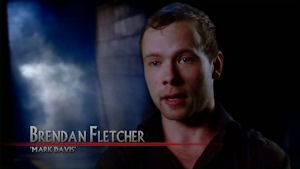
While Craven isn't a fan of the film ("It didn't do it for me"), Englund stands by it ("It's just a fun movie...it's kind of like a big comic book"). The cast remembers Brad Renfro, who was initially cast in the film (replacement Jason Ritter does not appear). Kane Hodder and his supporters also chime in to bemoan that he wasn't cast to play Jason, but the producers' reasoning seems pretty valid to me (Ken Kirzinger is not here, although he did contribute to His Name Was Jason; Sean Cunningham is also absent, although he contributed to both previous Nightmare features).
Monica Keena has fun recalling her experience, and it's crazy to see Scut from A Christmas Story all grown up: Zack Ward is a hoot, and helps invigorate this sequence; he and Brendan Fletcher apparently had a blast (be sure to watch the closing credits--Ward starts things off and set the tone perfectly). Along with all of the Part 2 contributors, Ward and Fletcher--along with Part 4/5's Hassel and Wilcox and Part 7's Newsom--are the stand-outs of Never Sleep Again.
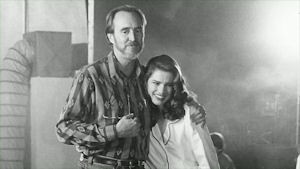
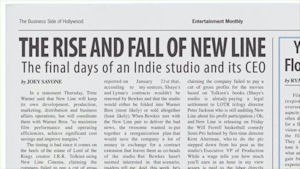
Our long journey comes to an end with a beautiful closing where all of the big names share their sense of pride on the projects--a love you can see and feel through every minute of these wonderful four hours. Whether it's Langenkamp sharing Craven's importance in her life or Craven expressing awe that his little film became such an influence and part of pop culture, it's a fitting finish. And no moment is more moving than watching Shaye's eyes tear up as thoughts both painful (his ouster from the company he created) and joyous cross in his mind as he thanks the fans for the incredible journey.
Right back 'atcha, Bob!
Note: Fans who have watched the bonus material on the 1999 box set (which included the 46-minute "Welcome to Primetime" retrospective on the original and roughly 96 minutes of interviews on the sequels through Part 7) and on the 2006 Infinifilm special edition (which included the 49-minute "Never Sleep Again" and the 22-minute "The House that Freddy Built: The Legacy of New Line Cinema") will be familiar with many of the stories in this new documentary. We've heard about the origins of Part 1, the homoeroticism in Part 2, the phallic Freddy snake in Part 3 and Shaye's clashing with Harlin in Part 4. But this new material is all new, far more expansive (with many more voices) and more cohesive. But the previous docs still offer some stories and contributors not here--most notably Ronee Blakley, Frank Darabont, Sean Cunningham and (!) Dick Cavett. Taken together, the three releases are about as comprehensive an exploration of the series that you'll ever see--with this 2010 documentary being the crown jewel.
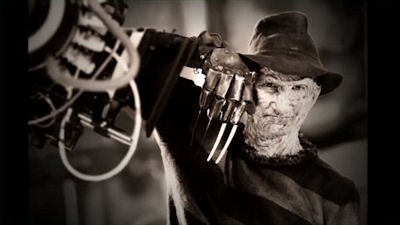
The Franchise
What better time than now to explore Freddy's nine feature films? Here's how I rank 'em, from four films I love to three I can enjoy to two that I hope I never see again...
The Modern Classic
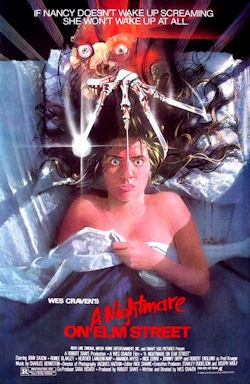 1. A Nightmare on Elm Street (1984)
1. A Nightmare on Elm Street (1984)Directed by Wes Craven
The Golden Age of the slasher was nearing its end when Wes Craven injected a much-needed dose of energy and originality into the increasingly stale genre. The disintegration of the American Family and the growing pains of teenagers alienated by out-of-touch parents provided a climate ripe for the picking. Craven decided to do just that in their nightmares--where a villain awaited to prey on their fears and instantly take his place alongside Hollywood horror royalty. Few slashers even try to make you think, but Nightmare succeeds on two levels--not just with the subtext of misunderstood and ignored youth, but also with the rules of the dream world. But if it's just genuine scares you want, it has plenty of those, too--including what still stands as one of the creepiest and coolest death scenes in all of horror history. After an eerie opening nightmare that establishes the film's gritty, independent tone perfectly, poor Tina (Amanda Wyss) has a date with death in her bedroom. It's a visceral, dynamic sequence that still works, and Craven has plenty more indelible images up his sleeve (Wyss in the body bag is just as chilling). The cast is a dream, from likeable heroine Heather Lagenkamp to boozed-up mom Ronee Blakely, from rising star Johnny Depp (in the Kevin Bacon role) to all-around badass John Saxon. Then there's that Robert Englund guy with his creepy glove, a shadowy menace with a frightening backstory. Nightmare isn't perfect--I never liked the final few minutes (says Lagenkamp: "Nothing really makes sense at this point...it's a confusing scene, because with the ending that we now have, it doesn't quite make sense"). But it's close--a modern classic that still manages to keep you up at night.
The Sleeper
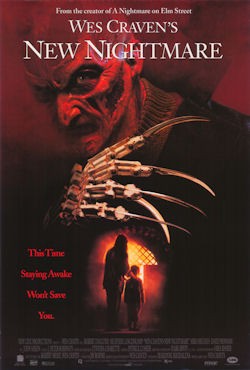 2. Wes Craven's New Nightmare (1994)
2. Wes Craven's New Nightmare (1994)Directed by Wes Craven
Lost in the shuffle and forgotten by many casual horror fans, Wes Craven's long-awaited return to the director's chair was also the lowest grossing Nightmare (damn you, Pulp Fiction!). It was also the most refreshing sequel the franchise produced--and by far the most ambitious, thought-provoking and genuinely scary one. New Nightmare has little in common with any other film in the series, offering a completely different experience that refused to resort to genre (and Elm Street) clichés. Set in the real world with the director and lead actors playing themselves, it's a unique look at art imitating life (or is that the other way around?). It's also a case of art imitating art: You can see Craven laying the groundwork for Scream here, and he also relies on the classic Hansel and Gretel fairy tale to prey on our childlike innocence and fears. This is Heather Lagenkamp's story, and you can feel the love the actor and director have for the "character". Strange happenings--including earthquakes, nightmares, creepy calls from a stalker and the odd behavior of her son Dylan (Miko Hughes)--have the actress questioning her sanity. The answer may be in Craven's latest project, a resurrection of the Nightmare series. The film is a lot slower and more subtle, a stark contrast in tone to every other franchise film. That makes the jolts and imagery all the more powerful, including a great sequence in the hospital, a tense playground scene, a creepy "movie within a movie" moment, telling words on a page (and computer screen) and a pretty killer opening sequence on the set (as for the traffic scene? I could do without that one...primarily because of the effects). Filled with nods to the original, New Nightmare doesn't show its hand too soon--rational explanations exist for much of Heather's paranoia, and as a suspicious doctor (the great Fran Bennett) starts to question her, we wonder if maybe she's just losing her grip. The script also pokes fun at Freddy's fame and the circus it (and Hollywood) had become, so the film to works on a view levels. Englund's participation is minimal (partially to separate him from the monster he's known for playing), while Freddy sports a new look and glove (which I love). I'm also thrilled to see John Saxon, although my one big wish was that Craven worked Amanda Wyss into the story. Her unforgettable scenes in the first film--and what she had to endure to get them on camera--are a perfect match for this story.
Dreamy Duo
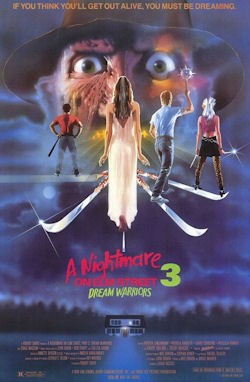 3. A Nightmare on Elm Street 3: Dream Warriors (1987)
3. A Nightmare on Elm Street 3: Dream Warriors (1987)Directed by Chuck Russell
The favorite of many a Nightmare fanatic--and perhaps the most popular sequel--Dream Warriors opts for a more fantasy-driven story and ups the comedy quotient with a lot more Freddy zingers. A disturbing trend of teenage suicide serves as the film's driving force, with a band of psychiatric hospital patients trying to use their dream powers to fight back. The film is filled with some of the more memorable kills in the franchise, and one of my all-time favorite sequences--a sleepwalking Phillip (Bradley Gregg) being led to his death as Freddy pulls his puppet strings (a.k.a. Phillip's tendons...eww!). The glorious return of Lagenkamp and Saxon go a long way in lending respectability to the film, giving it a crucial connection to the original (which it also shares a more honest look at teenage isolation with). Genre vets Craig Wasson (Body Double, Ghost Story) and Priscilla Pointer (Carrie) also up the cast's pedigree, while we get to see a young Laurence Fishburne in action (I also love Brooke Bundy). Patricia Arquette makes her feature film debut, and while she hasn't quite mastered the acting craft here, her Kristin is one of the more likable leads in the franchise. Dream Warriors is just a lot of fun, and I love the majority of it. While I could do with a lot less of Freddy's wisecracks, the film is full of energy, attitude, likable characters, some great imagery (the tiny mouths on Jennifer Rubin's arm? Eww again!) and a nice exploration of Freddy's backstory. But the film is also full of some excessive cheese--I hate (HATE!) the stop-motion skeleton battle, and some of the dream warrior battles are too silly for their own good ("In my dreams I'm beautiful...and bad!"). Still, this is easily one of the better sequels...and don't ya just love that Dokken song?!
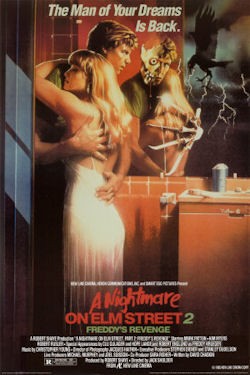 4. A Nightmare on Elm Street 2: Freddy's Revenge (1985)
4. A Nightmare on Elm Street 2: Freddy's Revenge (1985)
Directed by Jack Sholder
As Jeff Katz says: "Any movie with Clu Gulager and an exploding bird? Gotta be good!" Thought by many to be one of the worst in the series, I have to strongly disagree. Freddy's Revenge certainly has its problems, but so do almost all of the other sequels. Looking back, the film is absolutely fascinating for a few reasons--one being how the filmmakers refused to follow the original's template and did so many things different. We now have a hero, not a heroine, and the film's focus--that Freddy is trying to break into the world of the living by using a tortured teen as his puppet--means we spend far less time in the dream world. It's the kind of dramatic shift you'd expect to see later down the line, not immediately after the highly successful original. Sure, there's cheese like the crazy combustible parakeet, but there's still plenty of cool here, too: I dig the opening bus nightmare, the transformation of the lead character is pretty neat and--even though it ends prematurely and doesn't live up to its build-up--the awesome pool sequence gives the film a signature set piece. But beyond all that, it's the film's not-so-hidden homosexual undertones that give the film an entirely different perspective. Viewed through the lens of a young man trying to come to grips with his sexuality, it provides a few completely different viewing experiences--one that's heartfelt, tortuous and hysterical all at once (there are so many delicious bits of dialogue, props and story developments, I don't even know where to begin). Frankly, I'm stunned this was made and released in 1985. Save for Wes Craven's New Nightmare, this is the only thought-provoking sequel in the bunch--and the one with the best replay factor. Throw in Clu Gulager and Hope Lange, and I'm hooked.
Flawed but Fun Frightmares
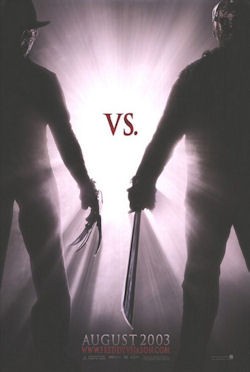 5. Freddy vs. Jason (2003)
5. Freddy vs. Jason (2003)Directed by Ronny Yu
This is where things start to get a little tougher, and the ranking of the next three films could shuffle at any given time for me. After his glove made a cameo at the end of Jason Goes to Hell--and after New Line finally had both killers in its legal stable--it was time for the match fans had been clamoring for. More of an anomaly in the Friday the 13th franchise than it is in the Nightmare franchise, Freddy vs. Jason is a comedic action film first and a horror film second. It fits Freddy far better than it fits Jason, and despite how I hate its departure from the best that both franchises had to offer, it's still a lot of fun. (I enjoy it more viewing it as a Nightmare film with a guest appearance by Jason than the other way around). It's well made and looks and feels more like a professional, cohesive work with a purpose, and does a decent enough job setting up a story that combines the two icons' mythologies. This has aged better than I thought, and I still get some enjoyment out of it...which is more than I can say for most of the films listed below. It just isn't really a horror film, so you have to accept it and roll with the action-packed punches. The cast is cool (and after watching this documentary, they have won me over even more) and so are many of the sequences, from the bed death to the awesome cornfield massacre to the final showdown by the lake. And the final images are pretty perfect, too.
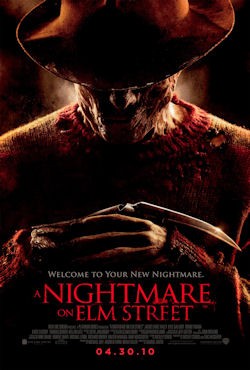 6. A Nightmare on Elm Street (2010)
6. A Nightmare on Elm Street (2010)
Directed by Samuel Bayer
I've only seen this entry once, so I'm not nearly as familiar with it. But after Freddy had grown into a stand-up comic and pop culture icon, I was relieved to at least see an attempt to return to somewhat darker, less cheesy material. Jackie Earle Haley is the perfect choice to fill Robert Englund's shoes, and even though I'm not thrilled with his makeup, overall he does a decent job in what had to be a difficult task (would you want to fill Englund's shoes?). This entry also has some decent chills and gore, although it's filmed and edited like a flashy music video too much. Connie Britton is one of the few actors to connect, and I wish she was used more. This remake pays homage to the original with a few scenes and kills, but doesn't do enough to really distinguish itself--and often feels like it's just going through the motions. The teenage characters here are where the film makes its biggest mistake, not fleshing them out nearly enough (a true wasted opportunity, because the cast is decent enough and could have handled better material--Rooney Mara wasn't given a chance as Nancy). The film's biggest strength is its exploration of Freddy's backstory, which it integrates nicely--and is altered with a brilliant stroke that puts his guilt in doubt, a truly terrifying possibility that puts a while new spin on the character and the film. Unfortunately, the film fumbles that intriguing subplot--giving it closure far too soon (they should have left the answer in doubt, something that would have fueled potential sequels). But even with the problems, I'd much rather watch this than Parts 5 and 6...and it at least plays more like a traditional horror film, which none of the film's below can claim. So for its tone alone, I appreciate this effort--and it seems fair to stick it near the middle (it's placement with Freddy vs. Jason was my hardest decision here).
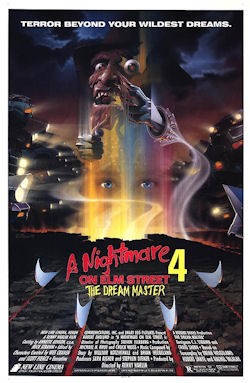 7. A Nightmare on Elm Street 4: The Dream Master (1988)
7. A Nightmare on Elm Street 4: The Dream Master (1988)
Directed by Renny Harlin
An opening quote from the Bible? Really?! This is where the franchise started to go south, setting off a trio of subpar efforts that lacked focus. By now, Freddy was a star, and the huge box office of his entry enabled the two films that followed (easily the worst of the bunch) to indulge in the awful excess of humor. Part 4 is filled with more jokes and a plethora of pop songs (well, at least it has some good pop songs, including Blondie's "In the Flesh" and Dramarama's "Anything, Anything"), proving where its priorities were (Freddy rapping? Oh dear God...no!). Patricia Arquette--having had enough of her Nightmare experience or not offered enough money--refused to return, leaving Kristen in the far-less charismatic hands of Tuesday Knight (at least Brooke Bundy returns as mom Elaine, one of the bright spots here). Rodney Eastman and Ken Sagoes reprise their roles from Dream Warriors, a connection the film should have taken better advantage of. Instead, they're killed off quickly (boo!), including a super-stupid Freddy resurrection via dog pee (at least the dog is named Jason). Kristen also gets the ax, but not before transferring her power (in another absurd scene) to new heroine Alice (Lisa Wilcox), Freddy's latest nemesis. This film is all over the place, and it misses more than it hits. Wilcox and Danny Hassel (as boyfriend Dan) are likeable, and a few of the effects are pretty cool--I like the waterbed kill (oh, Joey...falling for that naked lady trick again?!) and when Alice steps into the silver screen (a great idea that could have been done far better). I'm undecided about the Groundhog Day-esque sequence (one minute I like it, the next I hate it), and if it weren't for Parts 5 and 6, I'd say the death of Rick (Andras Jones) is the lamest Nightmare kill ever (um, where's Freddy?). And how about this exchange: "I didn't spend hours working out to let some night stalker beat me!" "You don't really get it...he's not a night stalker. And it'll take more than bench presses to beat him!" (Hmm, how many writers did this thing have?) But I will say this: The final lines of dialogue and subtle imagery that ends the film results in one of my favorite franchise endings, a nice show of restraint in an otherwise chaotic endeavor.
REMorseful
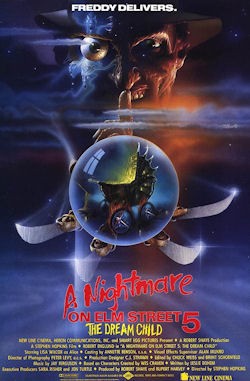 8. A Nightmare on Elm Street: The Dream Child (1989)
8. A Nightmare on Elm Street: The Dream Child (1989)Directed by Stephen Hopkins
Remember the decent Halloween 4 from 1988? And how the box office success had the studio bringing back some of the cast and hastily rushing out a sequel just a year later in 1989, resulting in one of the worst efforts in the franchise? Do you see where I'm going with this? The good news first: Lisa Wilcox and Danny Hassel return (yay!), as does Nicholas Mele in an underused role as Alice's recovering alcoholic dad. Part 5 is also slightly darker than Parts 3 and 4, but here are still plenty of Freddy quips to be found ("Bon appetite, bitch!"). There's also a decent extended opening, where Alice's nightmares start to take control just before graduation (the maniac asylum dream ain't half bad). But when I found myself face to face with the baby Freddy monster 18 minutes into the film, it was all over. Then comes the Terminator-like death of Dan on the motorcycle, another sequence that officially puts the series into absurd overdrive ("This boy feels the need for speed!"). As with Halloween 5 and Nightmare 4, this entry kills off a likeable, familiar character far too soon--a luxury the terrible script can't afford. Then there's Super Freddy vs. Phantom Prowler ("Time to die you scar-faced limp dick!") in a tribute to "Take on Me". Please no. (Death by A-ha video = lamest kill ever?) How about more stop-motion animation in a pointless pool sequence? Or another muddled script (how many writers did this take?!), including a head-scratching bit of dialogue from Yvonne's friend, a.k.a. Girl in Locker: "Hey, you missed practice! What happened? Did you fall in love or something?" (Um...what?) A baby stroller form hell? A creepy ghost kid? Some awful acting from the woman playing Freddy's mom? More Baby Freddy? Bad editing in the climatic kissing face transformation? A pathetic attempt to try and inflate its importance with the suggestion of an abortion/adoption debate? ("He's not a thing! He's part of me! And I'm not giving him to you or anyone else!") Make it stop. (But I do kinda like Yvonne's plant stand...look in the background around the 54-minute mark...)
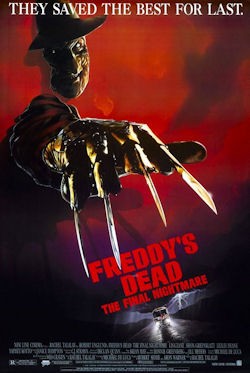 9. Freddy's Dead: The Final Nightmare (1991)
9. Freddy's Dead: The Final Nightmare (1991)
Directed by Rachel Talalay
This is what the series had come to? A live-action cartoon that hinged on 3D, cameo gimmicks (Roseanne and Tom? Hmm, that is pretty scary...) and weak riffs on popular catchphrases ("I'll get you, my pretty! And your little soul, too!")? An aimless work referencing its own franchise, starting with a pair of random, meaningless quotes--one from Nietzsche, one from Freddy ("Welcome to primetime, bitch!")? In the bonus features, some of those close to Part 1 call the idea of the 2010 remake "terrible", "painful", "recycling an idea" and "unimaginative". True or not, I'd say that Freddy's Dead is far more disrespectful to the spirit of the original than the 2010 remake. Part Wizard of Oz, part Twilight Zone, part Twin Peaks, part Bugs Bunny ("Boing! Boing!" sound effect in full force!), this concept is a really bad idea--and about as far away from Part 1 as you can get. It wastes the talents of Lisa Zane (playing an irresponsible therapist) and Yaphet Kotto, thrusts Roseanne and Tom upon us and reduces Freddy to a video-game playing product endorser ("Whataya know! I beat my high score!") in quite possibly the worst Elm Street sequence ever (an inauspicious start for Breckin Meyer in his feature film debut). It also shoves the insufferable Tracy (Lezlie Deane)--the most annoying Nightmare character ever--down our throats, attempting to humanize her with a superficial abuse subplot that has no true heart or soul. Modest Mussorgsky is probably having his own nightmares, too--his "Night on Bald Mountain" is clumsily inserted throughout in another attempt to remind us how unimaginative this entry is (the composition has class; this film does not). Springwood is now childless, leaving its adults to wallow in mass psychosis ("Fourteen hundred and ninety three, Freddie sailed across the sea!"). The only surviving Springwood teen--an amnesia-stricken John Doe (Shon Greenblatt)--might hold the key to Freddy's future. Alice Cooper shows up in a backstory that chronicles Freddy's teenage years, while Englund ditches the makeup to play the married Kruger before all hell broke loose. It's the one decent idea the film has, but it's handled horribly. The awful ending makes no sense ("3D glasses can be anything you want in dreams!"), and plays even worse in two dimensions. Johnny Depp agreed to come back for this?! What a waste of a cameo...
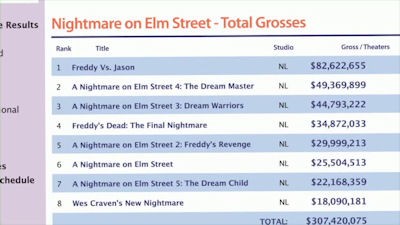
The DVD
Video:
The 1.85:1 anamorphic widescreen transfer is just fine, and varies with the source material. Film clips, stills and new interviews range in quality. The majority of the new interviews were all done in front of a green screen, which is more apparent in certain shots than others. Overall, the new material is sharp, crisp and colorful, although you'll notice some variation in quality (the Toy Newkirk, Shon Greenblatt and Tracy Middendorf interviews, for instance, are of lesser quality).
Audio:
The modest 2.0 track also gets the job done; no special effects or rear channel fireworks, but the dialogue is always crisp and clear. Subtitles are available in English.
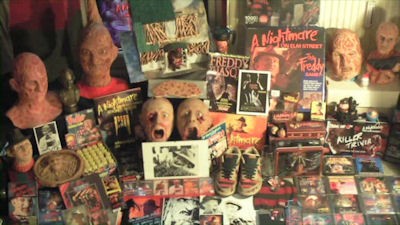
Extras:
As if the four-hour documentary wasn't enough to whet your Elm Street appetite, the second disc of bonus material includes nearly four more new hours of footage (phew...I'm exhausted!). Up first is a collection of extended interviews categorized by film, all just as interesting and informative as the main feature. There's extremely little repetition, so the disc does itself a disservice by calling these "extended"; it's more like "bonus". Each segment has a handful of topics that are touched upon, most of the clips ditching the fancy backgrounds in favor of the green screen. Here's what you get:
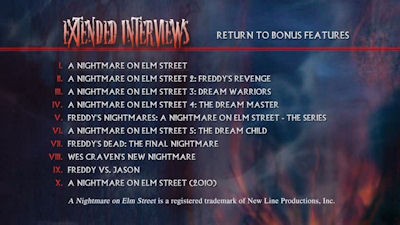
1. A Nightmare on Elm Street (13:14) More thoughts on the script, getting the project off the ground, props, effects, Nancy's grey hair, David Miller's mullet, some cut scenes and some people's fear that the general similarity to Dreamscape would spell doom in theaters.
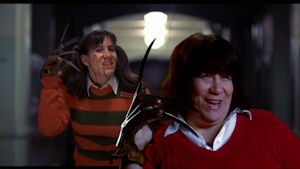
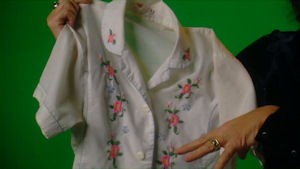
2. Freddy's Revenge (10:14) Again, one of the strongest segments--along with Part 4 and FvJ, the best ones here. The pressure on director Jack Sholder and the risk for New Line Cinema is discussed, but the coolest segments have Mark Patton talking about his boozing with Hope Lange, his screaming ("Everybody screams like a girl..."), the discomfort of the tongue prop and the homophobia in Hollywood that caused him to leave the industry ("I would have been decimated").
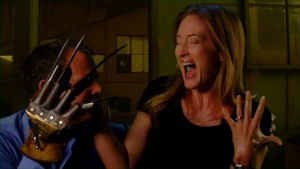
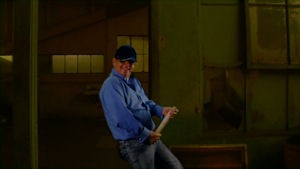
3. Dream Warriors (8:53) A few highlights have Rodney Eastman getting subjected to a "flick test", while Rachel Talalay talks about firing Chuck Russell's crew (one difficult Eastern European director of photography complained that he couldn't light Penelope Sudrow's "flat face").
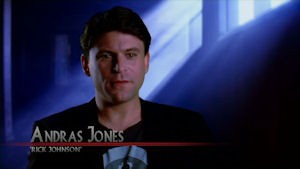
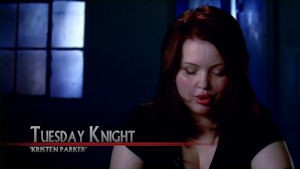
4. The Dream Master (13:28) Along with Part 2 and FvJ, this is the most entertaining segment. Lisa Wilcox talks about refusing to show her breasts despite Renny Harlin's prodding ("I stuck to my guns," she says without breaking a smile), while cinematographer Steve Fierberg also notes how Harlin didn't really understand the "dos and don'ts" with sexual themes in America. Wilcox's onscreen dad Nicholas Mele gets some time, Danny Hassel continues to be one of the most entertaining contributors and R. Christopher Biggs mentions he helped create two scenes so disgusting that he knew they would be cut--an attempt to distract the MPAA, perhaps (he won't tell us what they were). But the real juice comes from the discussion around the cast and crew's view of the Tuesday Knight--and the perceived favoritism shown to her by Harlin. "She was sort of the queen of the set without ever earning that right," notes Eastman. Adds Toy Newkirk: "It was all about Tuesday." Left out in the cold was Andras Jones: "It seemed like Renny had some kind of attitude about me, in some ways, that I didn't really understand."
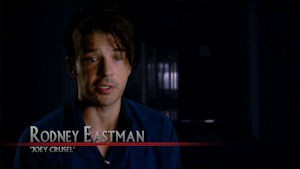
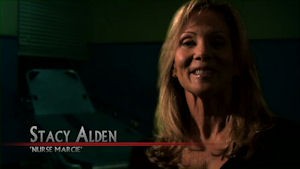
5. Freddy's Nightmares: The Series (5:05) Writers and directors share more on the short-lived syndicated series. "It's certainly the worst thing I've ever done, my worst work as a director," says Mick Garris. "But it was fun."
6. The Dream Child (11:04) The screenwriting drama is discussed: "Even though I fought to have my name actually on it, when I saw it, it was like, 'Hey! Could you put my name on [Part] 3 instead?' Cause that movie's really good," says John Skipp. Wilcox talks about her nude body double ("I see the triangle! This is not good!") and calls Stephen Hopkins out on a diss he made about the cast. Hassel talks about his decision to join the military--a great story that I wish got more time. As for Beatrice Boepple's thoughts about her scene in the hospital? TMI, Beatrice...TMI!
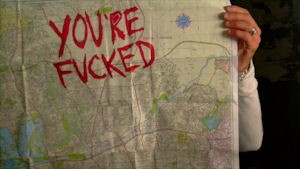
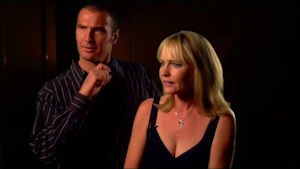
7. Freddy's Dead (8:57) The cast and crew talk about Talalay, who later talks about getting Johnny Depp to do a cameo. Lezlie Deane thinks the project was "ahead of its time with in-depth character development", while Shon Greenblatt talks about his brother--and getting his chest waxed.
8. New Nightmare (10:56) David Newsom makes me laugh some more, while the alternate babysitter subplot is further discussed (I kind of like the idea, and you can see how the film was hinting at it)--along with some effects and the "trick" shot at Heather's door. Lagenkamp also touches upon a disagreement she had with Craven over the script.
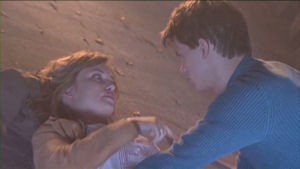
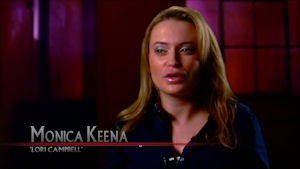
9. Freddy vs. Jason (19:04) One of the best parts of the bonus features. The studio's indifference to the project--and its various drafts--are discussed. Monica Keena talks about a line of dialogue Quentin Tarantino loved, while Brendan Fletcher and Zack Ward continue to crack me up--and also touch upon Ronny Yu's people skills. Says the director: "We are not here to shoot Hamlet...young actors take themselves too seriously; that create a little bit of tension on the set between them and me." All seem to agree there were too many cooks in the kitchen for this project.
10. A Nightmare on Elm Street: 2010 (2:34) The people most attached to the original seem to think the remake is a really bad idea (it hadn't been released at the time of these interviews). I understand their attachment to and love for the original, but I'm a tad surprised at some of the extreme opinions--which seem to ignore that Parts 4-6 did far more to hurt the franchise than the remake did. It's a little too "Boo hoo!" for my tastes, but at least Zack Ward gets in one last laugh.
All of the segments are worth a watch, and could easily have been included in the main feature. Ten more featurettes round out the second disc:
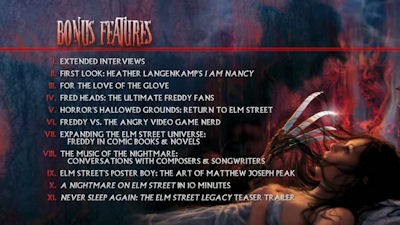
First Look: Heather Lagenkamp's "I Am Nancy" (6:53) The actress gives us a sneak peak at an upcoming documentary that looks at her role (on film and in life) as second fiddle to Freddy/Robert Englund, with a lot of horror convention encounters giving us an amusing look at her life.
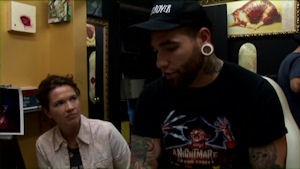
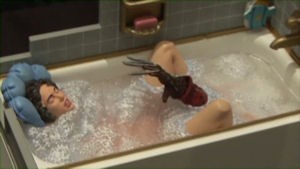
For the Love of the Glove (18:12) My brother actually made his own Freddy glove in the mid-1980s, but I had no idea it was such a big business. A handful of online entrepreneurs discuss their websites and work making custom Freddy gloves. "From what I'm understanding, I created one of the all-time sexual icons of the film industry," says Lou Carlucci. Robert Rusler also channels an angry Bob Shaye with a story from the set of Part 2, where a glove went missing...and now seems to be in the hands of self-proclaimed "Freddy Nut" Mike Becker.
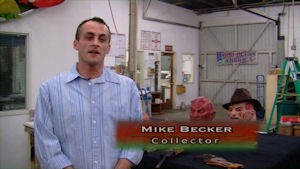
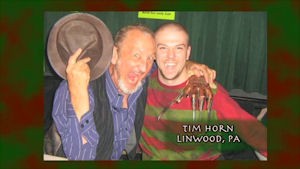
Fred Heads: The Ultimate Freddy Fans (12:49) discuses the icon's allure ("It's not a heroic identification that people have with Freddy," says Englund) and heads back to the conventions--and Becker's impressive collection of memorabilia. A lot of the actors talk about their show experiences, while Talalay shares how she helped a fan.
Horror's Hallowed Grounds: Return to Elm Street (23:18) The Part 1 episode of this great online series from Sean Clark visits all the old shooting locations of the classic film. It's a great trip down memory lane aided by Amanda Wyss and Lagenkamp (along with a few upset outcasts from Part 2 in a funny interlude). A lot of great tidbits surface here, as many of the locations were also used for other films (Mausoleum!). Lagenkamp's theory on how the film hit at a time when the "safe family neighborhood" was starting to slip away is an excellent one that speaks to part of the film's power. Also watch for a cool interview with the current owner of the infamous Thompson house. A great segment, this not only takes us back in time to a great movie--but an exciting period in horror filmmaking that will never be recaptured. (Sigh, those were the days!) Stay put for the cute closing credits ("Was it a sheep or a lamb? I thought it was a sheep...")
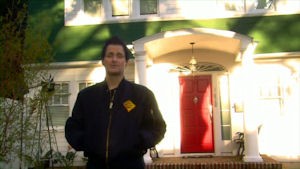
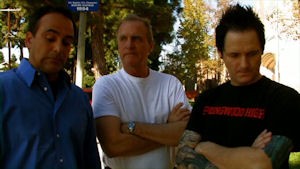
Freddy vs. The Angry Video Game Nerd (5:25) The only bonus feature I didn't like, this has James Rolfe cussing a lot as he visits the old Elm Street video game as part of his online series (it's almost identical in tone and content to the similar bonus feature on His Name Was Jason).
Expanding the Elm Street Universe: Freddy in Comic Books & Novels (15:17) talks with various writers and artists about how they expanded the nightmare, including their influences and ideas (and the challenge of having to sometimes sanitize Freddy).
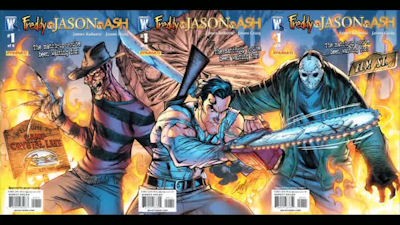
The Music of the Nightmare: Conversations with Composers & Songwriters (13:05) gives us more time with Part 1 composer Charles Bernstein, but the real treat is hearing from the others. Christopher Young talks about going orchestral with whales for Part 2, and notes that it's "too bad" the franchise doesn't have a consistently used, defining theme that links all the films (like Halloween and Friday the 13th have). Talalay talks about ditching Angelo Badalamenti's score for Part 3, while Dokken chimes in with more thoughts (the other two guys get to talk here!). Craig Safan talks about his involvement on Part 4, where he had no say in the plethora of pop songs used--including the original composition by star Tuesday Knight (hmm, seems Harlin really did like her...).
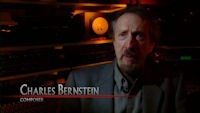
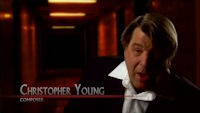
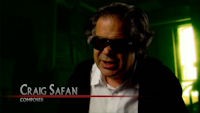
Elm Street's Poster Boy: The Art of Matthew Joseph Peak (7:21) The awesome work of the artist--who helped define the look of the series with his posters for the first five films--is briefly explored. Peak talks about hiding a Dreamscape monster in the poster for Part 1, which he (gasp!) actually tore up during an emotional period (most of it was saved, but the scars remain). He also talks about being forced to change Part 5's poster ("That was a little 'ouch' for me...it just didn't have--at all--the intensity and impact of the original concept") and being ditched on Part 6 (although he did get to do the work for the soundtrack).
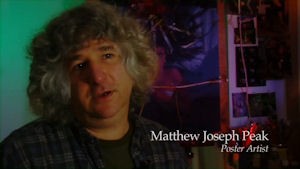
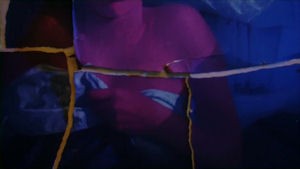
A Nightmare on Elm Street in 10 Minutes (actually running 9:53, which probably didn't sound as cool) presents an extended version of the actor line readings shown in the documentary's closing credits. Funny as hell, it's a great exclamation point on a great set of extras.
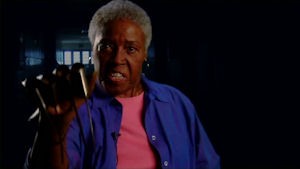
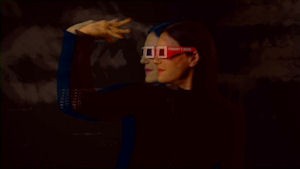
The film's trailer and a (somewhat disappointing) three-minute Easter Egg (scroll right from the first entry on the bonus disc's main menu to highlight a glove) with Part 1's Charles Fleischer round out the package.
Final Thoughts:
We've seen Nightmare on Elm Street retrospectives before, but none of them come close to matching the jaw-dropping material (nearly 8 hours worth!) on these two discs. Loaded with great stories from more than 100 contributors, the set is a bloody valentine to Wes, Freddy, Nancy, New Line and the entire cast and crew from one of horror's most popular franchises. Informative, funny and unafraid to tackle some controversy, it's an indispensible addition to any horror fan's library. (I can only hope that Friday the 13th can get this kind of love one day). This excellent look at a landmark franchise, the power of horror and the rise of a small studio living the American Dream comes Highly Recommended.
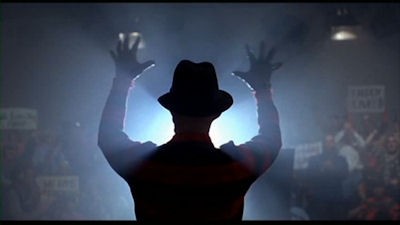
|
| Popular Reviews |
| Sponsored Links |
|
|
| Sponsored Links |
|
|
| Release List | Reviews | Shop | Newsletter | Forum | DVD Giveaways | Blu-Ray | Advertise |
|
Copyright 2024 DVDTalk.com All Rights Reserved. Legal Info, Privacy Policy, Terms of Use,
Manage Preferences,
Your Privacy Choices | |||||||









